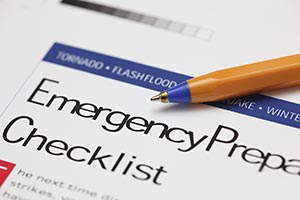Flood Safety: Before a Flood

You don't need to live near a dam or a river to experience a flood, a flood can occur anywhere it rains. Flooding can be quick and unexpected, and a few inches of water can cause thousands of dollars in damage to your home. Almost one quarter of flood claims come from areas deemed low-to-moderate risks areas according to the Federal Emergency Management Agency (FEMA). It's important to be prepared for a flood, no matter where you live.
Flood terminology
Before a flood happens in your area or home, familiarize yourself with the following terms to best understand the hazard you may be facing:
- Flood - An overflow of water on what is normally dry land. This may occur because of a river or other existing body of water or because of heavy precipitation. Floods are longer-term events, lasting days or weeks.
- Flash Flood - An excessive amount of water in a short period of time, generally less than six hours. A flash flood is usually caused by torrential rainfall that creates fast moving surges and can wash away everything in its path. A flash flood can also be the result of a levee or dam that fails or a sudden release of water by an ice jam.
- Flood Watch - Issued when flooding is possible. If you are under a flood watch listen to the radio or television for more information
- Flash Flood Watch - Issued when flash flooding is possible. If you are under a flash flood watch, be on alert because you may not always get advanced warning in a flash flood. Be prepared to move to higher ground quickly. Listen to the radio or television for more information.
- Flood Warning - Flooding is occurring or will occur soon. Evacuate if advised.
- Flash Flood Warning - Flash flooding is occurring. Seek higher ground on foot immediately and avoid already flooded areas.
Plan ahead for a flood
The best way to minimize damage to your home or the risk of danger from a flood is to plan ahead. A flood can often happen very quickly, leaving you with little time to do anything but evacuate. Here's how you can help make sure your family is ready to properly react in a flood:
- Know your property and area. What is the elevation and is it flood-prone? You should avoid building in flood-prone areas unless you elevate and reinforce your home. Are there dams or rivers that could pose a flood risk to your home? Learn evacuation routes in your community and where you should go if waters rise.
- Prepare your home. Make sure your sump pump is working and install a water alarm, which can warn you when water enters your home. Elevate appliances like your water heater, washer, dryer and furnace at least twelve inches above a projected flood elevation. Move furniture, valuables and important documents to higher stories in the home. Clear debris from gutters and downspouts to allow rainfall to run away from your home.
- Protect your assets and information. Create a "flood file" and keep in it an accessible waterproof and fireproof container. This file should contain: a room by room inventory of your possessions including photos, videos and receipts; a copy of your insurance with contact information for your agent and the claims phone number; and copies of critical documents, like financial records, social security cards, birth certificates, marriage license, will, deeds and titles, and a CD back-up of important computer documents or digital photos.
- Develop an emergency plan. Practice a flood evacuation route that includes routes from home, work and school. Ask an out-of-town relative or friend to be your emergency family contact, someone who all members of the family can call to let them know they are safe. Make sure you also consider the safety of any pets.
- Create an emergency kit. Have extra drinking water, non-perishable food, first-aid materials, blankets, a battery-powered radio, a flashlight, and extra batteries ready to grab in case you need to evacuate.
You should also consider flood insurance. Most homeowners policies do not provide coverage for flood. Check your policy's Declarations Page to see if flood coverage is listed. You can purchase a flood insurance policy from the National Flood Insurance Program (NFIP) issued by Foremost, as long as your community participates in the NFIP. Click here to learn more. Note that while you can purchase flood insurance at any time, there is a 30-day waiting period after you've applied and paid the premium before your policy is effective.
Learn more about flood insurance coverage
The information contained in this page is provided for general informational purposes only. The information is provided by Foremost® and while we endeavor to keep the information up to date and correct, we make no representations or warranties of any kind, express or implied, about the completeness, accuracy, reliability, suitability or availability with respect to the articles or the information, products, services or related graphics, if any, contained in the articles for any purpose. The information is not meant as professional or expert advice, and any reliance you place on such information is therefore strictly at your own risk.

Great Manufactured Home Rates
Get affordable coverage designed just for manufactured homes with the AARP Manufactured Home Insurance Program from Foremost.

Specialized Motorcycle Coverage
Protect your bike with a policy just for AARP members.
Learn more about motorcycle coverage from Foremost.
